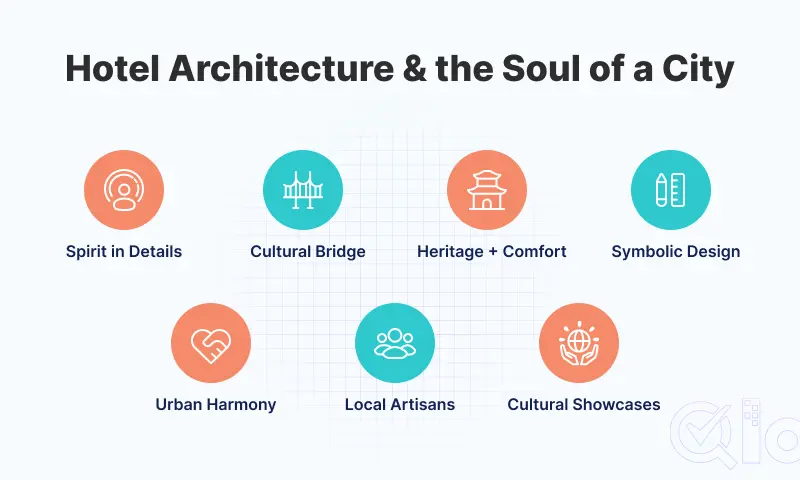Hotel design is not just construction and architecture – it’s a city’s voice. In its shape, colour, and material, it has a lot to say about local tradition, cultural values, and the rhythm of daily life.
Capturing the Spirit in Every Detail
A city’s personality lies in the minutest elements of its design. From the arches of the entrance to the artwork on the walls, everything makes the guest experience the city’s magic even before they step out.
Hotel Architecture as a Cultural Bridge
Hotels are most likely to be the first cultural experience that visitors experience. Their form can connect visitors directly to the city, providing a rich and unified experience through design.
Employing Local Materials to Achieve Authenticity
Employing the local materials not just contributes to the beauty but also to a sense of place. Wood, stone, or local bazaar materials provide the building with a strong sense of place.
A good example of local integration:
- Jaipur hotels with their identity defined by their pink sandstone facades.
- Hotels in Santorini are constructed with white volcanic rocks.
- Kyoto apartments with cedar and shoji screens.
Blending Heritage with Modern Comfort
Modern travelers want technology convenience, but also authenticity. Effective hotel design meets old-world elegance and new-world comfort without sacrificing cultural authenticity.
Urban Harmony in Hotel Architecture
A hotel needs to be a discreet part of its urban landscape. Its shape, size, and design need to be in proportion with the skyline, keeping streets and neighbours visually balanced.
Spaces that Evoke Emotions
The layouts of the corridor, ganden, and lobby can be emotive. Culture motifs, colors, and designs create a sense of belonging rather than accommodation.
Symbolism in Hotel Design
Local culture symbols employed can enrich a visitor’s experience. From carved plants on the wall to historical motifs in the flooring, these are subtle storytellers.
Public Spaces as Cultural Showcases
Hotels can act as cultural ambassadors by opening their public spaces to local art, music, and community gatherings. This integration builds bonds between the hotel and the city it represents.
Some symbolic design inspiration:
- Indian hotel carvings of a lotus.
- Nautical information in coastal tourist resorts.
- Mosaic artwork in the Mediterranean stays.
- Public spaces as cultural showcases.
Rooms that Whisper Local Stories
Every one of the guest rooms can be a mini-exhibit of the local culture. Employing indigenous fabrics, handcrafted furniture, and locally inspired artwork, the stay is an extended cultural exploration.

Partnering with Local Artisans
When hotels work with local artisans, it helps with design and preserving heritage. The tourist experience is more authentic, and the local community profits economically.
Benefits of artisan collaboration:
- Unique, one-of-a-kind handmade items.
- Financial support of home-grown talent.
- Preservation of culture through decor.
Designing for Climate and Landscape
Architecture must adapt to the natural conditions of the city. Tropical cities need ventilated designs, and mountain hotels require insulated buildings to keep the visitors comfortable.
Light as a Design Tool
Natural light adds architectural elements nd brings visitors closer to the outside. It creates a seamless connection between the hotel interior and the mood of the city.
Hotels as Guardians of History
Certain Hotels preserve old buildings and include them within modern structures. The blend allows visitors to stay in a part of the city’s past.
Sustainable Hotel Architecture
Sustainable design embodies a city’s vision for the future ideals. Invention and responsibility collide with green roofs, rain harvesting, and solar panels to give the city its family-oriented green facade.
- Green trends in hotels:
- Vertical gardens for natural cooling.
- Locally sourced and recycled materials.
- Smart energy management systems.
The Lasting Guest Impression
When the city’s character is embodied in hotel design, visitors depart with more than a memory book. They have a connection to the location, which compels them to return.
The Future of Hotel Architecture
The next era will combine smart technology, cultural respect, and sustainability. Hotels will continue to change as they are representations of their cities, while meeting all of the needs of a modern-day traveler.
Conclusion
The architectural aspect of a hotel is much more than design – it is a means of storytelling, linking cultures, and expressing the essence of a city. A hotel does all of this successfully; it balances the best service with the right atmosphere to create a stay that you will remember many years later as a true experience that had soul.
Get in Touch
Want to streamline your hotel operations? QloApps is ready to assist!
With QloApps’ Property Management System and Channel Manager, effortlessly manage your hotel and boost your revenue. Contact us today! QloApps
Be the first to comment.